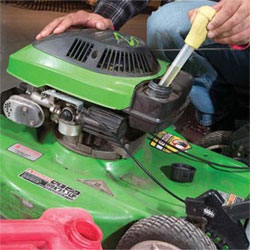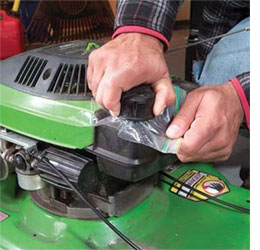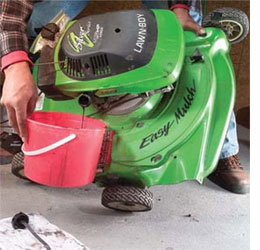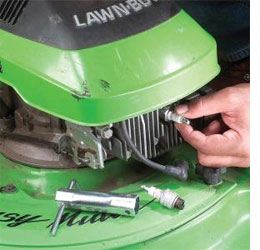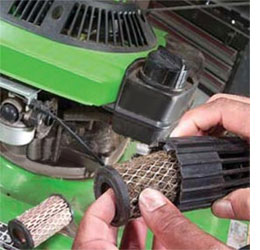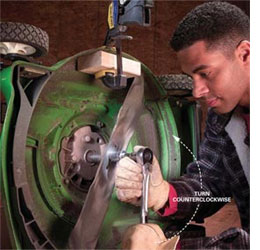Lawn mower maintenance and repair
Maintaining and servicing a lawn mower means that you spend less time mowing the lawn and more time enjoying your garden. There are five basic tasks that you can perform annually - and they'll only take a couple of hours and cost a few Rands - to keep your lawn mower running smoothly.
Use a manual suction pump to remove old petrol from the fuel tank and fill up with fresh petrol. Dirty petrol can cause several problems. A clogged carburetor is often caused by petrol that's been left in the mower too long.
Safety First
Petrol is highly flammable so work outdoors or in a well-ventilated area away from sparks and flame. Wipe up spills immediately and store leftover petrol in approved sealed containers.
Seal the gas tank by removing the gas cap and covering the opening with a plastic bag. Screw the cap back on over the plastic bag. Changing the oil in your lawn mower is recommended on a regular basis throughout the cutting season - every three months or thereabouts. It only takes about 15 minutes and costs less than R50 and greatly extends the life of your mower.
Older mowers have a fill plug close to the mower deck. Fill this type until oil reaches the threads of the refill hole. Two-cycle engines that use a petrol/oil mix for fuel don't have an oil reservoir on the engine and don't require oil changes.
Before you drain the old oil, run the mower a few minutes to warm the oil and stir up sediment. Then disconnect the spark plug, drain the old oil and add new . Use the right grade of oil recommended by the manufacturer.
There are two ways to drain old oil: through the filler neck or out the drain plug in the bottom of the engine. It's quicker and easier to drain the oil through the filler neck if your mower has one. If you have an older mower without a filler neck, locate the drain plug on the bottom of the engine and remove it to drain the oil. Pour used oil through a funnel into a plastic milk jug or other container and label it for recycling.
Safety First
Whenever you tip a lawn mower up on two wheels to work on the underside, only lift the side with the air cleaner. This prevents oil from running into the carburetor and soaking the air filter. Also, if your lawn mower has a fuel valve, turn it off.
Remember to check the oil level occasionally between oil changes, setting the mower on a level surface. Top it off as needed. Newer mowers have dipsticks with markings that indicate when to add oil. Don't overfill. Check your manual for instructions to see whether the dipstick should be fully screwed in or just set in when you're checking the level.
Often a new spark plug will make a big improvement in the way your engine starts and runs. Spark plugs are so cheap and easy to install that it's good insurance just to replace your plug every spring. Check your owner's manual for the correct spark plug, or take the old plug with you to the store to match it up.
If you don't own a socket wrench for changing the spark plug, pick up an inexpensive spark plug wrench when you buy your spark plug.
For pleated paper air filters: Locate the air filter near the carburetor. Unscrew, unsnap or twist off the cover to remove the old filter.
Air filters are easy to replace. Dirty air filters choke the engine, causing it to run poorly and lose power. If your lawn is dry and dusty, check the filter after every few mowings. Replace it when it starts to get plugged with dirt and debris. One common test is to shine a flashlight through the filter. If you can't see the light through the filter, replace it with a new one.
Most newer mowers have pleated paper filters that are either flat or cylindrical, while many older mowers have foam filters. Both types of replacement filters are readily available at lawn mower retailers and your local Builders Warehouse. Take your old filter along and have your mower manufacturer's name and model number handy.
In a pinch, you can wash foam filters in a solution of laundry detergent and water and allow them to air dry. But it's best to just buy a new one. In either case, saturate the foam filter in motor oil and squeeze out the excess before installing it.
Disconnect the spark plug wire, turn off the fuel valve and seal the gas tank when tipping a lawn mower on its side. Use a clamp and a block of wood to lodge the cutting blade against the block. Remove the blade by turning the large nut counterclockwise with a socket wrench.
A sharp blade will make your lawn mower cut like new. The cleanly cut grass will look better, and your mower won't bog down every time you hit a thick spot. If your lawn is rough and you mow over rocks and dirt spots, your blade may need to be sharpened several times during the season. Otherwise, once or twice should be plenty. Keep on top of the sharpening task by tuning up the blade with a file whenever it starts to dull.
Inspect the blade for cracks or worn-thin areas every time you sharpen it, paying special attention to the area at the base of the upswept section. Replace the blade with a new one if the metal is worn thin or cracked. You'll find the best selection of new blades at a lawn mower service centre or your lawn mower retailer.
Some maintenance is best left to the pros
While there are tasks that you can easily perform yourself, anything more should be left to your local lawn mower service agent.
the family handyman

